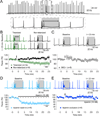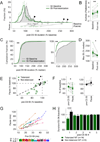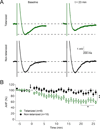Activity-Dependent Plasticity of Spike Pauses in Cerebellar Purkinje Cells
- PMID: 26972012
- PMCID: PMC4805497
- DOI: 10.1016/j.celrep.2016.02.054
Activity-Dependent Plasticity of Spike Pauses in Cerebellar Purkinje Cells
Abstract
The plasticity of intrinsic excitability has been described in several types of neurons, but the significance of non-synaptic mechanisms in brain plasticity and learning remains elusive. Cerebellar Purkinje cells are inhibitory neurons that spontaneously fire action potentials at high frequencies and regulate activity in their target cells in the cerebellar nuclei by generating a characteristic spike burst-pause sequence upon synaptic activation. Using patch-clamp recordings from mouse Purkinje cells, we find that depolarization-triggered intrinsic plasticity enhances spike firing and shortens the duration of spike pauses. Pause plasticity is absent from mice lacking SK2-type potassium channels (SK2(-/-) mice) and in occlusion experiments using the SK channel blocker apamin, while apamin wash-in mimics pause reduction. Our findings demonstrate that spike pauses can be regulated through an activity-dependent, exclusively non-synaptic, SK2 channel-dependent mechanism and suggest that pause plasticity-by altering the Purkinje cell output-may be crucial to cerebellar information storage and learning.
Copyright © 2016 The Authors. Published by Elsevier Inc. All rights reserved.
Conflict of interest statement
The authors declare no conflict of interest.
Figures




References
-
- Aizenman CD, Linden DJ. Rapid, synaptically driven increases in the intrinsic excitability of cerebellar deep nuclear neurons. Nat. Neurosci. 2000;3:109–111. - PubMed
-
- Bell CC, Grimm RJ. Discharge properties of Purkinje cells recorded on single and double microelectrodes. J. Neurophysiol. 1969;32:1044–1055. - PubMed
Publication types
MeSH terms
Substances
Grants and funding
LinkOut - more resources
Full Text Sources
Other Literature Sources
Molecular Biology Databases
Miscellaneous

